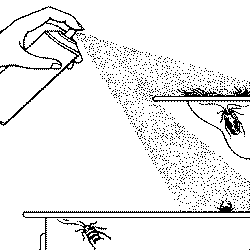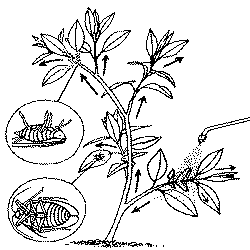Bactericides destroy, suppress or prevent the spread of bacteria. Examples include
- swimming pool chemicals containing chlorine
- products used to control black spot (bacterial blight) in gardens and
orchards
Household disinfectants and some industrial disinfectants are not usually
included in the definition of ‘pesticide’ as they clean objects rather than
dispose of pests.
Fungicides are used to control or destroy fungi such as
- grey mould on grape vines and fruit trees
- downy mildew on cucumbers
Herbicides destroy, suppress or prevent the spread of a weed or other unwanted
vegetation, for example, the herbicide glyphosate controls a range of weeds in
gardens and bushland, and on farms.
Insecticides control many insect pests, including
- thrips
- aphids
- moths
- fruit flies
- locusts
Products used on animals to control external parasites are considered
pesticides in NSW if they must be diluted or mixed with water. Products applied
directly to animals without being diluted, and treatments that are injected or
given internally, are classified as veterinary medicines and are regulated by
the NSW Department of Primary Industries under the Stock Medicines Act 1989.
Rodenticides are chemicals used for controlling rodents such as mice and rats.
Baits may be 'ready to
use', or are mixed with food. Different types of baits are available for
- large animals such as foxes and rabbits
- insects such as cockroaches and ants
- molluscs (snail and slug pellets)
Lures are chemicals that
attract a pest to a pesticide. Food-based lures, for example cheese in a
mousetrap, are not considered pesticides.
Genetically modified organisms (GMOs) have been genetically modified to make them more
resistant to pests and diseases. For example, genetically engineered Bt cotton includes a gene from the Bacillus thuringiensis bacterium that protects
the plant from bollworms.
GMOs used as pesticides are registered with the APVMA and subject to the
same regulations as other pesticides. For more information about GMOs in
Australia, see the Office of the Gene Technology Regulator.
Repellents repel rather than destroy a pest, for example, insect repellents repel
insects such as flies and mosquitoes.
Registering living
things as pesticides
A number of living organisms that can control pests have also been
registered as pesticides. Examples include
- Rabbit Haemorrhagic Disease that has been used to reduce rabbit numbers
- bacteria that act as biological insecticides and control insect larvae,
such as those of moths and mosquitoes




